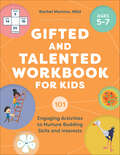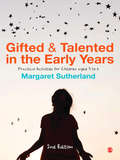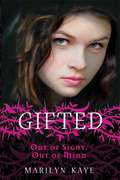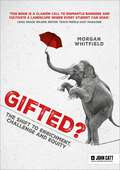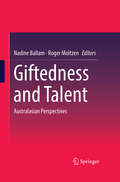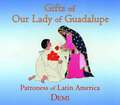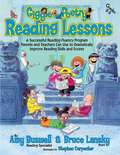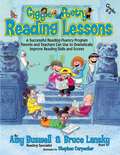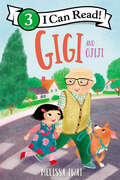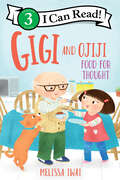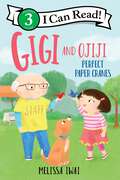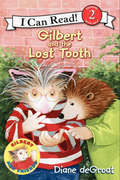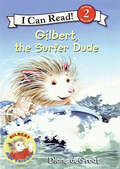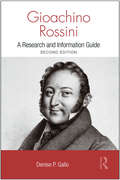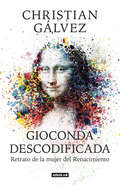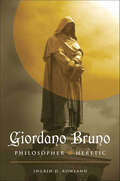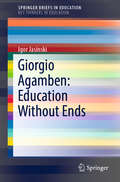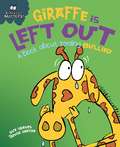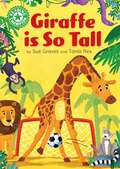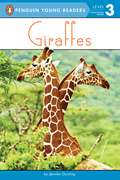- Table View
- List View
Gifted and Talented Workbook for Kids: 101 Engaging Activities to Nurture Budding Skills and Interests
by Rachel MartinoHelp kids hone their skills and intelligence with fun activities for ages 5 to 7The best way for kids to learn new things and test their skills is by solving problems and answering questions on their own. This colorful summer workbook gets them started, with 101 activities that are modeled after Gifted and Talented education programming. Each one is designed to engage kids and boost their academic ability, with exercises that cover everything from solving math problems and spotting patterns to critical thinking and writing.This workbook is an excellent summer bridge learning tool, keeping your child's mind active during the vacation. Its exercises ensure a smooth transition from kindergarten to 1st grade.Develop young minds—With a wide range of activities, kids will practice their test skills and explore topics like language, science, and art.Tips for parents—Each exercise includes a brief note to explain the different skills it teaches, so parents and caregivers know exactly what kids are learning.Next steps—Learn about Gifted and Talented programming and find out how this book can help kids prepare for placement assessments in the future.Give kids the tools to explore their skills and gain academic confidence with the Gifted and Talented Workbook for Kids.
Gifted and Talented in the Early Years: Practical Activities for Children aged 3 to 6
by Margaret Sutherland′This new edition advocates an inclusive approach and updates current theories, research and best practices in the field. The text incorporates 21st century skills, cultural perspectives and international education, and focuses on how to create appropriately challenging activities for the young gifted and talented child′Gillian Eriksson, Coordinator: Gifted Education Program, School of Teaching, Learning and Leadership, University of Central Florida ′This expanded edition builds on Margaret′s approach to teaching and learning, making us think how we can best include gifted and talented children in our early years settings. By providing opportunities for young children to learn from each other and from their communities and families, gifted and talented young learners can be appropriately challenged and recognised within an inclusive setting′ -Peter Merrotsy, Senior Lecturer in Gifted and Talented Education, University of New England, Australia Combining theoretical perspectives with practical activities, this book offers clear guidance on how to ensure you and your setting can identify and provide for very young children in your care who are gifted and talented. With an emphasis on providing the best learning opportunities for all, there is specialist advice for all staff working in early years settings. New to this new edition is: - information on recent research and new thinking in the field - international views of gifted and talented young children - links to the early years curriculum - new activities and ideas - extended coverage for young children aged 3 to 6 There are lots of ideas for things to try out in your setting, and photocopiable practical activities for parents to try out at home. Margaret Sutherland is a Lecturer in Additional Support Needs at the University of Glasgow and Director of the Scottish Network for Able Pupils (SNAP).
Gifted: Out of Sight, Out of Mind
by Marilyn KayeQueen of Mean Amanda Beeson is shocked to find herself in the body of one of her victims, Tracey Devon, who has the ability to become invisible. It soon becomes clear to Amanda that at Meadowbrook Middle School, the definition of "gifted" has a whole other meaning.
Gifted?: The shift to enrichment, challenge and equity
by Morgan Whitfield'Gifted and talented' is a zombie. It is dead, but still walking around. There are new labels to stratify students - 'more able', 'significantly able', 'high-aptitude learners'. New labels do not equal new thinking. The concept of 'gifted' is still stubbornly embedded in our educational structures, with its legacy of social immobility, racism and sexism. Students can be 'more able' when they have more financial resources, more access, more visibility, or more cultural acceptance. There are pervasive narratives that educators should prioritise extension for some students and not others. We can dispel the myth that pitching lessons judiciously to 'middle ability', and then differentiating up and down, is effective.This book explores how we can provide every student with rigorous challenge. Challenge for all is an inclusive approach to teaching, whereby every student is invited, and given the tools, to reach a place of mastery. This can be through project-based learning, Harkness round-tables, oracy, adaptive teaching, inclusive enrichment programs, dynamic classroom strategies and a schoolwide mission for equity. Educators can embed powerful knowledge into the curriculum, reimagine teaching to the top, and stretch learners through personalised and responsive instruction. The shift to enrichment, challenge and equity creates magnificent possibilities. The message to all students is: you belong here.
Gifted?: The shift to enrichment, challenge and equity
by Morgan Whitfield'Gifted and talented' is a zombie. It is dead, but still walking around. There are new labels to stratify students - 'more able', 'significantly able', 'high-aptitude learners'. New labels do not equal new thinking. The concept of 'gifted' is still stubbornly embedded in our educational structures, with its legacy of social immobility, racism and sexism. Students can be 'more able' when they have more financial resources, more access, more visibility, or more cultural acceptance. There are pervasive narratives that educators should prioritise extension for some students and not others. We can dispel the myth that pitching lessons judiciously to 'middle ability', and then differentiating up and down, is effective.This book explores how we can provide every student with rigorous challenge. Challenge for all is an inclusive approach to teaching, whereby every student is invited, and given the tools, to reach a place of mastery. This can be through project-based learning, Harkness round-tables, oracy, adaptive teaching, inclusive enrichment programs, dynamic classroom strategies and a schoolwide mission for equity. Educators can embed powerful knowledge into the curriculum, reimagine teaching to the top, and stretch learners through personalised and responsive instruction. The shift to enrichment, challenge and equity creates magnificent possibilities. The message to all students is: you belong here.
Giftedness and Talent
by Nadine Ballam Roger MoltzenThis book brings together recent postgraduate research in the broad area of giftedness, talent development and gifted education conducted across New Zealand and Australia. It addresses the significant demand for research in the field undertaken outside the United States and offers valuable practical insights. Divided into 14 chapters, the book explores giftedness and talent in a diverse range of socioeconomic cohorts and contexts, including examinations of gender, race and ethnicity. Though primarily intended for practitioners, it will also benefit undergraduate and postgraduate students, researchers and educators in New Zealand, Australia and beyond.
Gifts of Our Lady of Guadalupe: Patroness of Latin America
by DemiJust before dawn on Saturday the 9th of December, 1531, Juan Diego was on his way to Mass near Mexico City. He came to a hill known as Tepeyac just as day broke. He could hear the singing of many beautiful birds, but then the singing suddenly stopped. As he looked towards the top of the hill he heard someone calling his name. He was amazed to see a beautiful lady. Her clothes glimmered like the sun and her brilliance made the rocks and plants sparkle like jewels. Juan Diego bowed deeply before her, as she told him that she was Holy Mary, the Mother of God. Then she instructed him to go to the bishop in Mexico City and ask him to build a great church so that people would come to know her love, compassion, and protection. But the bishop wished for a sign. In this beautiful retelling of the story by award-winning author, Demi, find out how the miracles performed by the Virgin of Guadalupe persuaded the bishop to build the church; how they caused ten million Aztecs to convert to Catholicism within just eight years; and why the basilica dedicated to the Virgin of Guadalupe today receives 20 million pilgrims per year, making it the most popular Christian pilgrimage site in the world.
Gifts: The Joy of Serving God (Pursuing Spiritual Transformation)
by John Ortberg Laurie Pederson Judson PolingGifted--that’s you! Uniquely equipped to help build up the body of Christ. As a follower of Jesus, serving others is an integral part of your identity and an important key to your personal growth. But how do you cultivate a servant’s heart and your spiritual gifts in ways that build up your church, your family, your friends, and your world--without wiping you out in the process? Gifts guides you to the answers. Through personal study and small group interaction, this study will help you develop a passion to be used by God. You’ll find out about your unique place in the body of Christ and how to surmount the obstacles that keep you from thriving. You’ll discover the joy of serving with others--doing together what you cannot do alone. And you’ll learn how to abide in Christ, experiencing a freshness and vitality that grow as you give!Leader’s guide included!Gifts group sessions are:Use Me!Use My Gifts!Walking into WeaknessComparison: The Killjoy of ServanthoodThe Ministry of the MundaneServanthood’s Bell-Shaped CurveAbide in Him
Giggle Poetry Reading Lessons Sample: A Successful Reading-Fluency Program Parents and Teachers Can Use to Dramatically Improve Reading Skills and Scores
by Bruce Lansky Stephen Carpenter Amy BuswellSample Lesson from Amy Buswell and Bruce Lansky's Giggle Poetry Reading Lessons! Turn struggling readers into happy readers — For Grades 2–5.This sample lesson and introduction from Giggle Poetry Reading Lessons provides the research and methodology behind the most entertaining fluency intervention ever! As well as a kid-tested poem, customized reading lesson, an off-the-wall illustration, and zany performance tips—all designed to make the process of reading more like fun than work! Perfect for teachers and parents who want to help children improve their reading. Check out the full version of Giggle Poetry Reading Lessons available in softcover and eBook for the full lesson plan.
Giggle Poetry Reading Lessons: A Successful Reading-Fluency Program Parents and Teachers Can Use to Dramatically Improve Reading Skills and Scores
by Bruce Lansky Stephen Carpenter Amy BuswellHow Giggle Poetry Reading Lessons Turn Struggling Readers into Happy Readers -- For Grades 2-5.Many struggling readers are embarrassed to read aloud. They are often intimidated or bored by texts that conventional programs require them to practice. So, instead of catching up, they fall further behind. Currently 67% of American fourth graders can't read grade-level text. Reading specialist Amy Buswell has spent eight years looking for remediation methods that work. "What is needed," Buswell explains, "is a program that improves the motivation of struggling readers, because that accounts for 90% of the problem." Four years ago, Buswell came up with a brainstorm. She knew her best readers enjoyed reading Bruce Lansky's poetry books for pleasure. The more poems they read, the better their reading got. Why not use Lansky's kid-tested poems as texts struggling readers could practice on to improve their reading--using six research-based strategies: choral reading, echo reading, paired reading, repeated reading, sustained silent reading and "say it like the character" reading. -- This book is the result of that brainstorm and the resulting collaboration between Buswell and Lansky. It gives teachers and parents everything they need to help children improve their reading: -35 kid-tested poems by Bruce Lansky -35 customized reading lessons by Amy Buswell -35 off-the-wall illustrations by Stephen Carpenter -35 sets of zany performance tips by Bruce Lansky ...all of which is designed to make the process of reading improvement more like fun than work. -- What Amy Buswell and Bruce Lansky have created is the most entertaining fluency intervention ever. That's why it is so successful at overcoming negative attitudes to improve reading skills and scores. Ninety-five percent of participating students made significant improvement in their fluency (reading rate). And average reading scores on the Florida Comprehensive Assessment Test (FCAT) for Buswell's school raised her school's rating to an A for the first time. In 2011, Buswell's school achieved one of the highest-percentage reading gains in the county. -- There's no reason parents can't get in on the fun, too. Parents will enjoy Lansky's funny poems and Stephen Carpenter's delightful illustrations as much as their children. By reading the poems with their children and encouraging their children to try some of Lansky's entertaining performance tips (by adding gestures, sound effects, props and finding additional readers: be they friends, family or neighbors), they can dramatically speed up their child's reading progress (and have lots of fun in the process.)
Gigi and Ojiji (I Can Read Level 3)
by Melissa IwaiGigi, a biracial six-year-old girl, learns about her Japanese culture from her grandfather when he comes to visit. Perfect for social emotional learning. <p><p>Gigi can’t wait for her Ojiji—Japanese grandpa—to move in. Gigi plans lots of things to do with him, like playing tag, reading books, and teaching Roscoe, the family dog, new tricks. But her plans don’t work out quite the way she’d hoped. And her grandpa doesn’t seem to like Roscoe. Will Gigi find a way to connect with her Ojiji? <p><p>This exciting new I Can Read series is brought to you by author-illustrator Melissa Iwai, whose popular books include Soup Day and Dumplings for Lili. Gigi and Ojiji is a Level Three I Can Read book. Level 3 includes many fun subjects kids love to read about on their own. Themes include friendship, adventure, historical fiction, and science. Level 3 books are written for early independent readers. They include some challenging words and more complex themes and stories. The story contains several Japanese words and a glossary of definitions and pronunciations.
Gigi and Ojiji: Food for Thought (I Can Read Level 3)
by Melissa IwaiA Geisel Honor–winning series! Join Gigi as she tries natto, a traditional Japanese food, in this exciting and engaging Level Three I Can Read book by acclaimed author and illustrator Melissa Iwai. Intergenerational relationships, Japanese culture, and social and emotional learning are highlighted in this sweet biracial story, perfect for sharing with children 3 to 6. Ohayo! It’s breakfast time and Gigi can’t wait to make her favorite meal—Peanut Butter Toast. Yummy! But Ojiji doesn’t like peanut butter. How can anyone NOT like peanut butter? Ojiji prefers Japanese foods—like natto, made from fermented soybeans. Will Gigi learn to love a new breakfast treat? This story highlights the close relationship of Gigi and her grandfather and the importance of trying new things!This exciting and engaging I Can Read series is brought to you by author-illustrator Melissa Iwai, whose popular books include Soup Day and Dumplings for Lili.Gigi and Ojij: Food for Thought is a Level Three I Can Read book. Level 3 includes many fun subjects kids love to read about on their own. Themes include friendship, adventure, historical fiction, and science. Level 3 books are written for early independent readers. They include some challenging words and more complex themes and stories. The story contains several Japanese words and a glossary of definitions.Praise for Gigi and Ojiji:"Gigi crafts her Japanese American identity in this enchanting early reader. The cuteness, inclusivity, and cross-cultural problem-solving represented will have young readers coming back again and again. A must-buy." —School Library Journal (starred review)"The text is well supported by the endearing illustrations, which capture all of Gigi’s big emotions and depict her as a biracial child, with a white father and Japanese mother." —Booklist (starred review)"An affirming option in the quickly diversifying field of early-reader books." —KirkusA 2023 Theodor Seuss Geisel Honor titleEl día de los niños, el día de los libros selection 2023ALSC Notable 2023CBC Teacher and Librarian Favorites Award 2023A Bank Street Best Children's Book of the Year in the 5-9 beginning reader category (2023)
Gigi and Ojiji: Perfect Paper Cranes (I Can Read Level 3)
by Melissa Iwai"A cheery, gentle lesson on the importance of “practice makes perfect.” —School Library Journal (starred review)A Geisel Honor–winning series!Gigi loves the Japan Day Festival! When Ojiji volunteers at the origami booth, Gigi can’t wait to make a paper crane like Ojiji’s. But folding paper is harder than it looks, and Gigi is disheartened when she sees her paper crane next to Ojiji’s. Will Gigi give up or will she try her best? Author-illustrator Melissa Iwai’s next installment in this I Can Read series encourages readers to try a new activity and to never give up.Gigi and Ojiji: Perfect Paper Cranes is a Level Three I Can Read book, which is geared toward kids who read on their own but still need a little help. The story contains several Japanese words, a glossary, and instructions on how to fold a paper puppy.Praise for Gigi and Ojiji:"Gigi crafts her Japanese American identity in this enchanting early reader. The cuteness, inclusivity, and cross-cultural problem-solving represented will have young readers coming back again and again. A must-buy." —School Library Journal (starred review)"The text is well supported by the endearing illustrations, which capture all of Gigi’s big emotions and depict her as a biracial child, with a white father and Japanese mother." —ALA Booklist (starred review)"An affirming option in the quickly diversifying field of early-reader books." —Kirkus ReviewsA 2023 Theodor Seuss Geisel Honor titleEl día de los niños, el día de los libros selection 2023ALSC Notable 2023CBC Teacher and Librarian Favorites Award 2023A Bank Street Best Children's Book of the Year in the 5–9 beginning reader category (2023)A Junior Library Guild Gold Standard Selection
Gigi and Ojiji: What's in a Name? (I Can Read Level 3)
by Melissa IwaiGigi wants to go by something besides her baby name—but her full name, Geraldine, is too long to write and Hanako, her middle name, doesn’t feel quite right. Will Gigi find the perfect name?This exciting new I Can Read series is brought to you by author-illustrator Melissa Iwai, whose popular books include Soup Day and Dumplings for Lili.Gigi and Ojiji: What’s Iin a Name? is a Level Three I Can Read book. Level 3 includes many fun subjects kids love to read about on their own. Themes include friendship, adventure, historical fiction, and science. Level 3 books are written for early independent readers. They include some challenging words and more complex themes and stories. The story contains several Japanese words and a glossary of definitions.Praise for Gigi and Ojiji:"Gigi crafts her Japanese American identity in this enchanting early reader. The cuteness, inclusivity, and cross-cultural problem-solving represented will have young readers coming back again and again. A must-buy." —School Library Journal (starred review)"The text is well supported by the endearing illustrations, which capture all of Gigi’s big emotions and depict her as a biracial child, with a white father and Japanese mother." —Booklist (starred review)"An affirming option in the quickly diversifying field of early-reader books." —Kirkus
Gilbert and the Lost Tooth (I Can Read Level 2)
by Diane deGroatWho lost a tooth? Gilbert's tooth is wiggly and loose all through spelling and lunch. Then he scores a run in kickball and—BAM!—his tooth is knocked right out of his mouth! Gilbert is so excited that the tooth fairy will be visiting. But Lewis is jealous of Gilbert's lost tooth and comes up with a sneaky plan. Will the tooth fairy fall for Lewis's trick?
Gilbert, the Surfer Dude (I Can Read Level 2)
by Diane deGroatGilbert, star of a number of perennial bestsellers, enjoys a fun-filled day at the beach.
Gilgamesh (SparkNotes Literature Guide Series)
by SparkNotesGilgamesh (SparkNotes Literature Guide) Making the reading experience fun! Created by Harvard students for students everywhere, SparkNotes is a new breed of study guide: smarter, better, faster.Geared to what today's students need to know, SparkNotes provides:chapter-by-chapter analysis explanations of key themes, motifs, and symbols a review quiz and essay topics Lively and accessible, these guides are perfect for late-night studying and writing papers.
Gioachino Rossini: A Research and Information Guide (Routledge Music Bibliographies)
by Denise P. GalloGiochino Rossini: A Research and Information Guide is designed as a tool for those beginning to study the life and works of Gioachino Rossini as well as for those who wish to explore beyond the established biographies and commentaries. The first edition was published in 2001, and represented a survey of some 878 publications relating to the composer’s life and works. The second edition is revised and updated to include the more than 150 books and articles written in the field of Rossini studies since then. Contents range from sources published in the early decades of the nineteenth century to works currently in progress. General subject areas include Rossini's biography, historical and analytical studies of his operatic and non-operatic compositions, his personal and professional associations, and the reassessment of his role in the development of nineteenth-century music.
Gioconda descodificada: Retrato de la mujer del Renacimiento
by Christian Gálvez¿Cuál es la verdadera identidad que se esconde tras el cuadro más famoso del mundo? Existen al menos cinco referencias históricas reales que certifican la existencia de un retrato femenino de manos de Leonardo da Vinci. Un encargo que, al parecer, nunca entregó. Sin embargo, a la hora de identificar a la modelo de la Gioconda, las palabras de Agostino Vespucci, Antonio de Beatis, Giorgio Vasari, Cassiano dal Pozzo y el Anónimo Gaddiano no coinciden. ¿A qué retrato se refieren cada uno de ellos? ¿Al cuadro que exhibe el Museo del Louvre en París y que mundialmente se reconoce como Lisa Gherardini, la esposa de Francesco del Giocondo, o por el contrario al retrato que hoy en día cuelga en las paredes del madrileño Museo del Prado? ¿Son compatibles ambos retratos? ¿Coinciden esas imágenes con el resto del imaginario de la Gioconda, tales como La Mona Lisa de Isleworth o La Monna Vanna? ¿Es Leonardo elcreador de cada una de estas representaciones femeninas? ¿Cuáles son los enigmas que esconde la Gioconda y cómo se gestó su ascenso meteórico a la fama? A través de estas páginas examinaremos la situación global del rol femenino en el Renacimiento, descubriremos a mujeres brillantes que la historia eclipsó, pondremos en valor el papel de la mujer en la evolución del retrato en la Historia del Arte y analizaremos todas las teorías que eruditos, historiadores y expertos en arte han elaborado en torno a la representación femenina en la obra Leonardo da Vinci con el propósito de encontrar la verdadera identidad del retrato más conocido de la historia de la humanidad: la Gioconda. Lo que la crítica ha dicho de Leonardo da Vinci -cara a cara-:«Un profundo estudio histórico y artístico en busca del verdadero rostro de Da Vinci.»David Zurdo, Qué Leer «Christian Gálvez tiene algo de hombre del Renacimiento. Su curiosidad innata, el respeto a los clásicos y su capacidad de trabajo le han granjeado no solo una legión de seguidores, sino la consideración de los mayores especialistas de la historia y el arte de ese tiempo.»Alberto Frutos de Dávalos, Revista Historia «Cuando un outsider llama a las puertas de la comunidad científica y estas se abren, será por algo. Una de las mejores mezclas de rigor y pasión que he leído.»Jorge Alcalde, QUO
Giordano Bruno: Philosopher/Heretic
by Ingrid D. Rowland“Ingrid D. Rowland brings before us today the pieces of an extraordinary sixteenth-century life . . . This is intellectual biography at its best.” —Peter N. Miller, The New RepublicGiordano Bruno is one of the great figures of early modern Europe, and one of the least understood. Ingrid D. Rowland's pathbreaking life of Bruno establishes him once and for all as a peer of Erasmus, Shakespeare, and Galileo, a thinker whose vision of the world prefigures ours.By the time Bruno was burned at the stake as a heretic in 1600 on Rome's Campo dei Fiori, he had taught in Naples, Rome, Venice, Geneva, France, England, Germany, and the “magic Prague” of Emperor Rudolph II. His powers of memory and his provocative ideas about the infinity of the universe had attracted the attention of the pope, Queen Elizabeth—and the Inquisition, which condemned him to death in Rome as part of a yearlong jubilee.Writing with great verve and sympathy for her protagonist, Rowland traces Bruno's wanderings through a sixteenth-century Europe where every certainty of religion and philosophy had been called into question and shows him valiantly defending his ideas (and his right to maintain them) to the very end. An incisive, independent thinker just when natural philosophy was transformed into modern science, he was also a writer of sublime talent. His eloquence and his courage inspired thinkers across Europe, finding expression in the work of Shakespeare and Galileo.Giordano Bruno allows us to encounter a legendary European figure as if for the first time.“A loving and thoughtful account of [Bruno’s] life and thought, satires and sonnets, dialogues and lesson plans, vagabond days and star-spangled nights.” —John Leonard, Harper’s
Giorgio Agamben: Education Without Ends (SpringerBriefs in Education)
by Igor JasinskiItalian critical theorist Giorgio Agamben may be best known for his political writings concerning the curtailing of privacy rights in the wake of 9/11 and the status of prisoners of war and refugees. Yet, casting him primarily as a political theorist is misleading given his significant contributions to the fields of linguistics, literary theory, philosophy, aesthetics, and religious studies. This book provides the first ever comprehensive introduction to Agamben’s work as it pertains to the field of education. Written in a clear and accessible style, Giorgio Agamben: Education without Ends is an invaluable resource for anyone interested in thinking education beyond its current standardized forms.The first part of the book creates a context by highlighting formative experiences in Agamben’s biography that reflect a particular idea of education on the threshold between life and work. The second part introduces the notions of infancy, study, community, and happiness, and discusses their relevance with regard to key issues in educational theory and practice. The third part shows how conceptual constellations based on Agamben’s work can inspire studious practices within the spatial, temporal, and curricular infrastructure of educational institutions as they exist today.
Giraffe Is Left Out - A book about feeling bullied (Behaviour Matters #4)
by Sue GravesThis simple, engaging story is the perfect way to introduce young children to what bullying is, and help them become aware of how their behaviour can impact on other children.There are even suggestions for activities and ideas to talk through together to help children understand.When Leopard arrives at Jungle School, Giraffe doesn't want to include him and tries to exclude him from joining in. So when Leopard has a birthday party he doesn't invite Giraffe, even though he has invited all his friends. Slowly Giraffe begins to understand how Leopard must have felt when he started school. Can the two of them learn to become friends after all? The Behaviour Matters series of picture books provide a gentle means of discussing emotions, boosting self-esteem and reinforcing good behaviour. Supports the Personal, Social and Emotional Development Area of Learning in the Early Years Foundation Stage, and is also suitable for use with children in KS1 and can be used to discuss values. Suitable for children under 5.
Giraffe is Tall: Independent Reading Green 5 (Reading Champion #515)
by Sue GravesThis story is part of Reading Champion, a series carefully linked to book bands to encourage independent reading skills, developed with Dr Sue Bodman and Glen Franklin of UCL Institute of Education (IOE)Reading Champion offers independent reading books for children to practise and reinforce their developing reading skills.Fantastic, original stories are accompanied by engaging artwork and a reading activity. Each book has been carefully graded so that it can be matched to a child's reading ability, encouraging reading for pleasure.
Giraffes (National Geographic Kids Readers)
by Laura MarshExplore the African savanna with giraffes in this exciting reader. Packed with beautiful and engaging photos, kids will learn all about these amazing animals. This level 1 reader is carefully leveled for an early independent reading or read aloud experience, perfect to encourage the scientists and explorers of tomorrow!
Giraffes (Penguin Young Readers, Level 3)
by Jennifer DusslingGet to know the tallest animals on earth—giraffes!—in this Level 3 reader.Giraffes have been a source of interest for thousands of years. Some were even kept as pets in Egypt! As the tallest animals on Earth—some can be nineteen feet tall—giraffes are distinct, and their anatomy makes them only more interesting. Did you know that giraffes have the same number of neck bones that humans do? Giraffes also have tongues that are blue-black in color and more than a foot long. You can learn all about giraffes in this exciting book!
